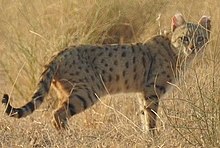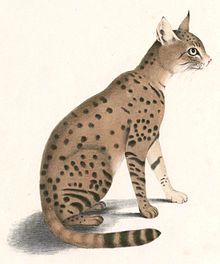Asiatic wildcat
| Asiatic wildcat | |
|---|---|

| |
| Scientific classification | |
| Domain: | Eukaryota |
| Kingdom: | Animalia |
| Phylum: | Chordata |
| Class: | Mammalia |
| Order: | Carnivora |
| Suborder: | Feliformia |
| Family: | Felidae |
| Subfamily: | Felinae |
| Genus: | Felis |
| Species: | |
| Subspecies: | F. l. ornata
|
| Trinomial name | |
| Felis lybica ornata Gray, 1830–1832
| |
The Asiatic wildcat (Felis lybica ornata), also known as the Asian steppe wildcat and the Indian desert cat, is an African wildcat subspecies that occurs from the eastern Caspian Sea north to Kazakhstan, into western India, western China and southern Mongolia.[1][2] There is no information on current status or population numbers across the Asiatic wildcat's range as a whole, but populations are thought to be declining.[3][4]
Taxonomy

Felis ornata was the
- Chaus caudatus by Gray in 1874 was a skin and skull from the Bukhara Region in Uzbekistan.[6]
- Felis shawiana by William Thomas Blanford in 1876 was a pale wildcat skin from Yarkand in Xinjiang, western China.[7]
- Felis (Felis) kozlovi by Konstantin Satunin in 1904 was a wildcat skin from an oasis in the Turpan Depression in western China.[8]
- Felis (Felis) murgabensis and Felis (Felis) matschiei by Geok Tepe in Turkmenistan, respectively.[9]
- Felis ornata nesterovi by Alexei Birulya in 1916 was a female wildcat skin from Lower Mesopotamia.[10]
- Felis ornata issikulensis by Sergey Ognev in 1930 was a skin and skull of a male wildcat from the southwestern shore of Lake Issyk-Kul in Kyrgyzstan.[11]
In the 1940s, Reginald Innes Pocock reviewed the collection of wildcat skins and skulls in the Natural History Museum, London and subordinated all the spotted wildcat specimens to Felis lybica, arguing that size of skulls and teeth do not differ from those from African range countries.[12]
Characteristics
The Asiatic wildcat's fur is light sandy coloured with small rounded spots on its upper body. These spots are solid and sharply defined, and do not occur in clusters. The spots on the chest and abdomen are much larger and more blurred than on the back, and usually do not form transverse rows or stripes on the trunk. Its colours and patterns vary greatly. The hairs along the spine are usually darker, forming a dark gray, brownish or ochreous band. The upper lips and eyelids are light, pale yellow-white. The facial region is of an intense gray colour, while the top of the head is covered with a dark gray coat. In some individuals, the forehead is covered in dense clusters of brown spots. A narrow, dark brown stripe extends from the corner of the eye to the base of the ear. The lower neck, throat, neck, and the region between the forelegs are devoid of spots, or only with indistinct spots. The thighs are distinctly striped. The underside is whitish, with a light gray, creamy or pale yellow tinge. The tail is mostly the same colour as the back, with the addition of a dark and narrow stripe along the upper two-thirds of the tail; it appears thin, as the hairs are short and close-fitting. The tip of the tail is black, with two to five black transverse rings above it.[13]
The Asian wildcat has a long, tapering tail, always with a short black tip, and with spots at the base. The forehead has a pattern of four well-developed black bands. A small but pronounced tuft of hair up to one cm long grows from the tip of each ear. Paler forms of Asian wildcat live in drier areas and the darker, more heavily spotted and striped forms occur in more humid and wooded areas. The throat and ventral surfaces are whitish to light grey to cream, often with distinct white patches on the throat, chest and belly. Throughout its range the Asian wildcat's coat is usually short, but the length of the fur can vary depending on the age of the animal and the season of the year. Compared to the domestic cat, Asian wildcats have relatively longer legs. Males are generally heavier than females.[1]
In Pakistan and India, wildcats have pale sandy yellow coats, marked with small spots that tend to lie in vertical lines down the trunk and flanks.[14][15] The wildcats of
The Asiatic wildcat weighs about 3–4 kg (6.6–8.8 lb).[14][15]
Distribution and habitat
The
In Iran, the Asiatic wildcat has been recorded in arid plains, lush forests, coastal areas and mountains, but not in extremely high altitudes and deserts.[17]
In Afghanistan, the Asiatic wildcat has been recorded prior to 1973 in the central Hazarajat mountains and the steppe region, near Shibar Pass and Herat, and in Bamyan Province.[18]
In
In
In the 1990s, wildcats were reported common and populations stable in the lowlands of Kazakhstan. A pronounced loss of range has been documented in Azerbaijan.[25]
Within China, the Asian wildcat is distributed in
Ecology and behaviour
Asiatic wildcats are frequently observed in the daytime. They frequently use rock crevices or burrows dug by other animals.[13]
Hunting and diet
In
In the scrub habitat of western Rajasthan, they live largely on desert
Results of a feed item analysis of Asiatic wildcats in the
Parasites and infestations
The wildcat is highly parasitised by
Threats
Female Asiatic wildcats mate quite often with domestic males, and hybrid offspring are frequently found near villages where wild females live.[13] They have been hunted at large in Afghanistan; in 1977 over 1200 pelts manufactured into different articles were on display in Kabul bazaars.[18]
Conservation
The Asiatic wildcat is included on
References
- ^ a b Nowell, K.; Jackson, P. (1996). "Asiatic Wildcat Felis silvestris, ornata group (Gray 1830)". Wild Cats: Status Survey and Conservation Action Plan. Gland, Switzerland: IUCN/SSC Cat Specialist Group. pp. 99−101.
- ^ Kitchener, A. C.; Breitenmoser-Würsten, C.; Eizirik, E.; Gentry, A.; Werdelin, L.; Wilting, A.; Yamaguchi, N.; Abramov, A. V.; Christiansen, P.; Driscoll, C.; Duckworth, J. W.; Johnson, W.; Luo, S.-J.; Meijaard, E.; O’Donoghue, P.; Sanderson, J.; Seymour, K.; Bruford, M.; Groves, C.; Hoffmann, M.; Nowell, K.; Timmons, Z.; Tobe, S. (2017). "A revised taxonomy of the Felidae: The final report of the Cat Classification Task Force of the IUCN Cat Specialist Group" (PDF). Cat News. Special Issue 11: 17−20.
- ^ . Retrieved 27 July 2022.
- ^ Jutzeler, E.; Xie, Y.; Vogt, K. (2010). "Cats in China: Asian wildcat" (PDF). Cat News (Special Issue 5): 42–43.
- ^ Gray, J. E. (1830–1832). "Felis ornata Gray. Beautiful cat". Illustrations of Indian Zoology; Chiefly Selected from the Collection of Major-General Hardwicke, F.R.S. Volume 1. London: Treuttel, Würtz, Treuttel, Jun. and Richter. p. Plate 2.
- ^ Gray, J. E. (1874). "On the Steppe-Cat of Bokhara (Chaus caudatus)". Proceedings of the Zoological Society of London: Plate VI−VII, 31−33.
- ^ Blanford, W. T. (1876). "Description of Felis Shawiana, a new Lyncine cat from Eastern Turkestan". The Journal of the Asiatic Society of Bengal. 45 (2): 49−51.
- ^ Satunin, K. (1904). "Neue Katzenarten aus Central-Asien" [New cat species from Central Asia]. Annuaire du Musée Zoologique de l'Académie des Sciences de St. Pétersbourg. 9: 524−537.
- ^ Zukowsky, L. (1914). "Drei neue Kleinkatzenrassen aus Westasien" [Three new races of small cats from West Asia]. Archiv für Naturgeschichte. Abteilung A. 80 (10): 124−146.
- ^ Birulya, A. (1916). "De Felibus asiaticis duabus novis" [About two new Asiatic cats]. Annuaire du Musée Zoologique de l'Académie des Sciences de St. Pétersbourg. 21 (Supplement): I−II.
- ^ Ogneff, S. I. (1930). "Übersicht der russischen Kleinkatzen" (PDF). Zeitschrift für Säugetierkunde. 5 (2): 48−85.
- ^ Pocock, R. I. (1951). "Felis lybica, Forster". Catalogue of the Genus Felis. London: Trustees of the British Museum. pp. 50−133.
- ^ ISBN 9004088768.
- ^ ISBN 9780510399009.
- ^ ISBN 978-0-226-77999-7.
- ^ Groves, C. P. (1980). "The Chinese mountain cat (Felis bieti)". Carnivore. 3 (3): 35–41.
- ^ Ghoddousi, A.; Hamidi, A. Kh.; Ghadirian, T.; Bani’Assadi, S. (2016). "The status of Wildcat in Iran - a crossroad of subspecies?". Cat News (Special Issue 10): 60–63.
- ^ ISBN 9788188722068.
- ^ a b Sharma, I. K. (1979). "Habits, feeding, breeding and reaction to man of the desert cat Felis libyca (Gray) in the Indian Desert". Journal of the Bombay Natural History Society. 76 (3): 498–499.
- .
- ^ Dookia, S. (2007). "Sighting of Asiatic Wildcat in Gogelao Enclosure, Nagaur in Thar Desert of Rajasthan". Cat News (46): 17–18.
- .
- ISBN 978-93-5279-561-1. Archived from the originalon 7 August 2020. Retrieved 9 August 2019.
- ^ "Sloth bear surprise for experts in Mirzapur forests | Lucknow News - Times of India". The Times of India. No. Lucknow. The Times of India. 2019. Retrieved 9 August 2019.
- ^ Belousova, A.V. (1993). "Small Felidae of Eastern Europe, Central Asia, and the Far East: survey of the state of populations". Lutreola. 2: 16–21.
- ISBN 978-0691099842.
- ^ a b Abdukadir, A.; Khan, B.; Masuda, R.; Ohdachi, S. (2010). "Asiatic wild cat (Felis silvestris ornata) is no more a 'Least Concern' species in Xinjiang, China" (PDF). Pakistan Journal of Wildlife. 1 (2): 57–63.
External links
- "Asiatic Wildcat". IUCN/SSC Cat Specialist Group.
